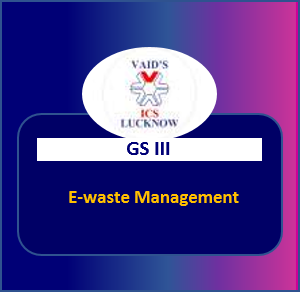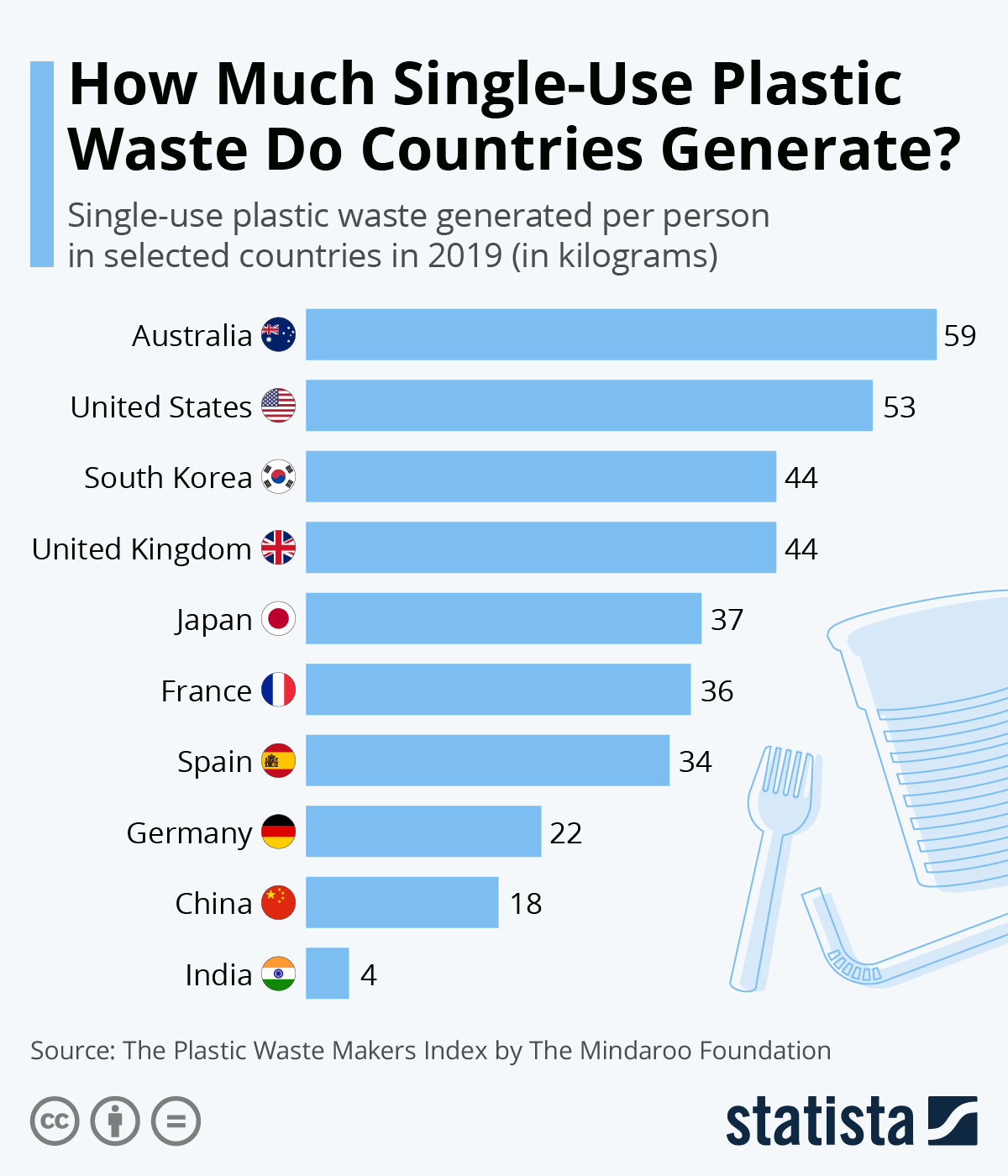CURRENT AFFAIRS
Get the most updated and recent current affair content on Padhaikaro.com
E-waste Management
- Vaid's ICS, Lucknow
- 21, Aug 2021

Why in News:
the E –waste Management has been a mojor concern in dealing with the environmental pollution.
Facts
- 6 Million tons (Mt) of e-Waste was generated in the world in 2019.
- Only 17.4% of the total e-Waste generated in the world was recycled.
- India produced almost 1.9 Million Tons of e-waste in 2015.
- In India, 95% of the e-Waste generated is managed by the informal sector.
Extended Producer Responsibility:
It refers to the responsibility of the manufacturer or producer of the electronic products to dispose of the same in an environmentally sustainable manner.
- It includes take-back or setting up the collection centres to facilitate the consumers in product disposal.
- E-waste management rules, 2011 were amended in 2016 to include collection targets for the producers.
e-Waste
E-Waste: It refers to the waste generated by discarding the used electronic products, such as computers and mobile phones.
Reasons for the growing e-Waste in India: E-waste in India is growing because of multiple reasons including:
Rapid growth of electronics industry:
- Electronics industry has grown rapidly in India over the years.
- It has almost tripled from US$ 11.5 billion in 2004-05 to US$ 32 billion in 2009-10. As the sector has grown resource-intensive, waste generation is bound to rise.
World’s 2nd largest smartphone base:
- India is the world’s second largest smartphone market in the world.
- The active internet users are likely to touch a number of 90 Crores by 2025 from 62 Crores in 2020, pointing to a growth of almost 45% in 5 years.
- This will further increase the smartphone penetration in the country, leading to a considerable increase in e-waste generation in the country.

Rapid upgradation of Technology:
- The smartphone industry has seen rapid growth in India.
- This has led to an increase in the number of smartphone brands in the country, with every one of them promising better and more upgraded products. Similarly, the introduction of 5G technology has boosted the replacement level of smartphones as per their compliance to the technology.
- This points to a faster rate of smartphones becoming obsolete and their entry into the e-waste system.
Shipping from Developed nations:
Due to the prohibitory costs of recycling electronic wastes, many companies in the western countries go for cost effective method of shipping the waste to developing countries like India. This prevents such companies from the local laws, which are stricter in the developed nations.
Corona pandemic:
- The spread of corona pandemic was accompanied with physical lockdown and work from home provisions.
- This has led to a rapid surge in the sales of electronic products in the country. Similarly, the spread of online education is also contributing to the growth in electronic industry.
- This is bound to increase the production of e-waste in the country in the long term.
Predominance of Informal Sector:
- As already mentioned, e-waste management in India is predominantly undertaken in the informal sector.
- Informal sector thrives upon unauthorized waste collection with untrained individuals. The formal sector is not enthusiastic about e-waste management due to prohibitory initial investment.
Inferior Working Conditions:
- Handling of e-waste management in India is mostly done by rag-pickers and other workers, who are not properly trained for the task.
- They are underpaid and are unaware of the safety requirements of the job. They get the disposed-off electronic wastes mostly from the waste handlers or the repair shops.
High Initial investment:
- Despite the government rules as well as media attention, there is a dearth of authorized collection centres in the country because of the high initial investment.
- The big players are not interested in the sector, due to the lack of return on the investment. There is a need for the government to incentivize setting up of the recycling plants in the interest of public safety and public health in the country.
Danger to Health:
- Unsafe disposal of the e-waste has the potential to cause damage to the health of individuals coming in contact with the harmful elements and the chemicals contained in the e-waste, like Lead, Cadmium etc.
- If unchecked, this would lead to an increase in the public health expenditure in the country, effectively shaving off few percentage points from the GDP of the country in the long run.
Danger to Environment:
- Improper recycling of the e-waste in the informal sector may lead to spillage of harmful chemicals into the environment.
- It might mix in the air, leading to air pollution, or pollute groundwater, making it unfit for human consumption. Therefore, there is a need to train the workers to handle the e-waste appropriately.
Loss of Valuable Material:
- Again, e-waste has valuable components like rare earth metals as the constituents of electronic products.
- India is already deficient in the production of rare earth metals and is dependent on their imports. This leads to dependence on imports as well as loss of precious foreign exchange. Therefore, it is imperative that such valuable components are extracted for reuse in the industry.
Lack of Awareness: It is not only the handlers, who are not aware of the proper handling procedure of the e-waste, even the general public does not the consequences of unsafe handling of the e-waste. Even the technologically advanced people in the country have little knowledge of the ways of proper disposal and the waste collection centers in the area.
Way Forward:
Better implementation of the Rules:
- India had introduced the Electronic Waste (Management and Handling) Rules in 2011, with initiatives like Extended Producer Responsibility (EPR – see inset) within its ambit. They were amended in 2016.
- However, the media has reported about their lax implementation in the country, which needs to be corrected.
Creation of infrastructure:
- E-waste sector in India suffers from lack of requisite infrastructure including metal processing equipment.
- This makes the recyclers export the waste material, thus losing access to valuable rare earth and other metals.
- Ultimately, the country has to import these metals back from the foreign countries.
- Therefore, there is a requirement for Viability Gap Funding in the industry as well as to provide adequate incentives to the industry.
Formalization of the industry:
The formal industry is unable to compete with the informal sector as the informal sector has no overheads like protective equipment costs and no administrative necessities.
There is a need for better implementation of the rules to disincentivize the informal sector from extending better prices to the aggregators.
Responsible e-waste Management:
There is a need for India to work together with other developing nations to control the dumping of e-waste in the developing countries. It has serious ramifications for the target country’s public health system.
Shifting Responsibility to Producers:
The manufacturers and the producers of the electronic waste need to be incentivized to produce better products which are easier to recycle.
By using the mechanism of Extended Producer Responsibility, the government has made sure that since it is the producers who will ultimately recycle the products, they will use lesser toxic and easily recyclable material in the products.
Conclusion:
India is one of the largest e-waste producers in the world. Therefore, it is imperative that it takes effective steps to ameliorate the crisis brewing in the form of uncontrollable production of e-waste in the country.
Time and again, the media has pointed to the ineffective implementation of the well-intentioned policies as the biggest challenge to environmental sustainability in India.
Facts for Prelims:
SonChiraiya:
- The ‘SonChiraiya’ brand and logo was launched by the Ministry of Housing and Urban Affairs for marketing urban Self-Help Group (SHG) products.
- This initiative will prove as a step in the right direction towards increased visibility and global access for the products made by urban SHG women.
Blue Berets or Blue Helmets
UN peacekeepers (often referred to as Blue Berets or Blue Helmets because of their light blue berets or helmets) can include soldiers, police officers, and civilian personnel. Peacekeeping forces are contributed by member states on a voluntary basis. Civilian staff of peace operations are international civil servants, recruited and deployed by the UN Secretariat.
Features:
- United Nations Peacekeeping helps countries torn by conflict create conditions for lasting peace.
- Peacekeeping has unique strengths, including legitimacy, burden sharing, and an ability to deploy and sustain troops and police from around the globe, integrating them with civilian peacekeepers to advance multidimensional mandates.